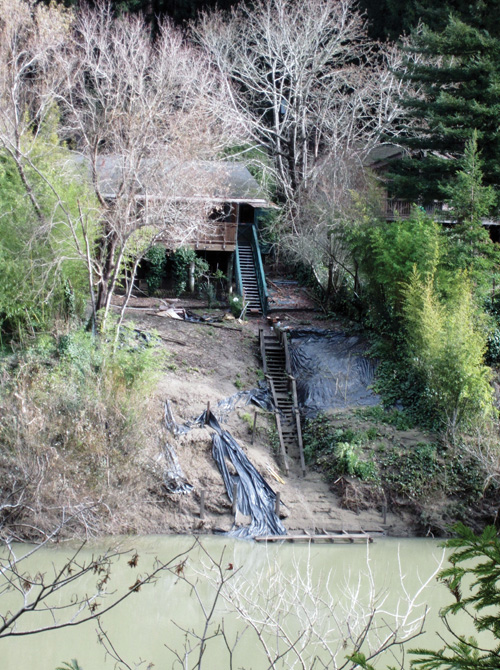“The Russian River watershed is a rich and diverse region of nearly 1500 square miles of forests, agricultural lands and urban lands in Mendocino and Sonoma Counties. The mainstem of the Russian River flows 110 miles from its headwaters near Redwood Valley and Potter Valley to the Pacific Ocean near Jenner. The
watershed is home to approximately 360,000 people, 150 streams and creeks, and about 30 species of fish – three of which are listed as threatened or endangered, Chinook salmon, Coho salmon and Steelhead trout.”
— from “Russian River-Friendly Landscape Guidelines”
Russian River watershed advocates were delighted to find landscapers lining up to get into a workshop next week about River-friendly landscaping.
“It’s exciting,” said Virginia Porter, Executive Director of the Russian River Watershed Association that’s hosting the Jan. 29 seminar offering free advice to landscape professionals and “watershed stewards.”
When the seminar was announced two weeks ago more than 120 people —mostly professional landscapers — signed up to attend in the first week, said Porter.
Two years ago the Association published “Russian River–Friendly Landscape Guidelines,” a 66-page pamphlet that will form the basis for next week’s gathering.
The event includes presentations, talks and a tour of Santa Rosa city gardens demonstrating watershed-friendly alternatives to the conventional suburban landscape of lawns, roses and sprinklers.
“It will be a full morning of ideas and demonstrations of how to make these guidelines grow in our Russian River watershed,” said Porter.
It’s all part of an ongoing outreach effort to make people aware of what a watershed is and that we all live in one — and to remind us that the Russian River watershed needs all the help it can get.
“Every square inch of land in this watershed is linked to that River,” said Porter.
As the guidelines note, conventional landscaping too often relies on large lawns, non-native plants, lots of watering and heavy use of fertilizers and pesticides. These landscapes need mowing, blowing, trimming and removal of plant debris that often winds up in the county landfill.
“Tons of plant debris are still thrown away each year,” in conventional landscaping, according to the guidelines. “Leaves and clippings alone are sixth out of the ten most prevalent material” in California’s waste disposal systems.
Despite progress, the growing interest in watershed-friendly gardening is far from universal. A Watershed Association survey completed last year showed that a majority of people living in Sonoma County don’t even know what a watershed is.
“Just over one-third (35 percent) of the population recognizes that they live in a watershed, with those living in Santa Rosa being further removed from that knowledge than those living in unincorporated county areas,” according to the survey.
One question survey respondents were asked was, “As far as you know, do you live in a watershed?”
About one-third (35 percent) of the total sample “know that they live in a watershed,” the survey found. About half (47 percent) said they do not, and 18 percent “are unsure.”
Only 41 percent understand that water entering streets, street drains and storm drains goes directly into a river or other waterway, the survey found, and only 42 percent of those surveyed understand that a watershed is a land area that drains into a specific body of water.
Finally, though somewhat lacking in knowledge, people do feel empowered. When they were asked if they think they, personally, can have any effect on protecting the water quality in the Russian River, local creeks or other local bodies of waters, “76 percent said they could,” said the survey by Data Instincts, the Windsor-based public outreach consultants who conducted the survey.
The Russian River Watershed Association was formed in 2003 “to create opportunities for our member agencies to expand their stewardship role in the watershed,” says the Association’s website, rrwatershed.com.
Watershed Association members are the cities of Cloverdale, Cotati, Healdsburg, Rohnert Park, Santa Rosa, and Ukiah, the Town of Windsor, the County of Sonoma and the Sonoma County Water Agency
36.2
F
Healdsburg
March 9, 2025








